Vanillaware’s tribute to classic side-scrolling action role-playing games has garnered a lot of attention over the past few years for its exaggerated, overly sexualised character designs. An hour into playing the actual game, I stopped noticing.
Those designs don’t go away, of course. There isn’t a piece of equipment in the game capable of covering up the comically massive thighs of my beloved Amazon warrior. The Dwarf never covers his rippling pecs, and the Sorceress’ questionable wardrobe choices are maintained throughout the course of this epic adventure.
It’s the context that changes the perspective. Presented in a short trailer or a series of screenshots, these fantastic characters certainly draw the eye and invite criticism. Once I spent some time in designer George Kamitani’s highly stylised fantasy world, these otherwise freakish figures fell into place. They became the subjects in a fabulous interactive tableau, where every screenshot is a work of art (minus the user interface and damage numbers, of course).
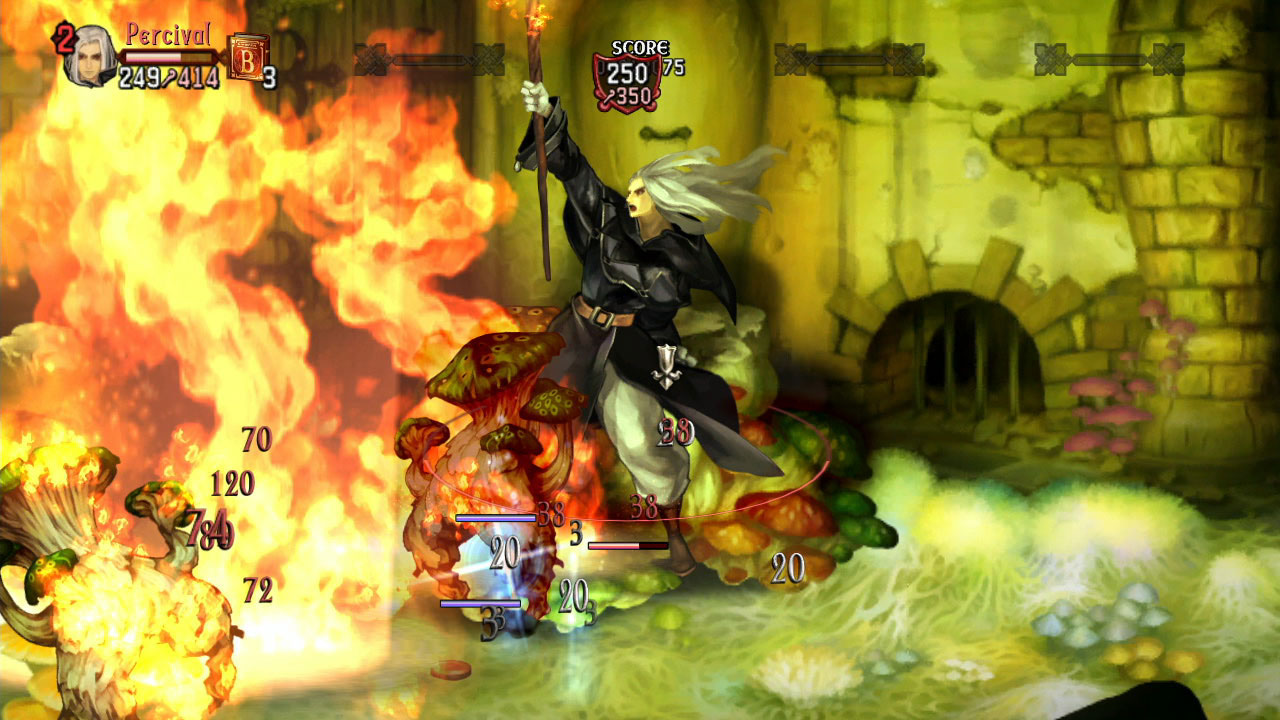
The gorgeous visuals obscure a desperate world battling a desperate situation. The eponymous Dragon’s Crown is an all-powerful magical artefact, sought after by dark forces wishing to use it for sinister purposes. Players are tasked with securing the artefact before that happens, saving the world in the process.
In the grand tradition of games like Golden Axe and the Dungeon & Dragons arcade games from Capcom (which George Kamitani worked on), the plot is a flimsy excuse for players to join together and hack, slash and cast their way to greatness.
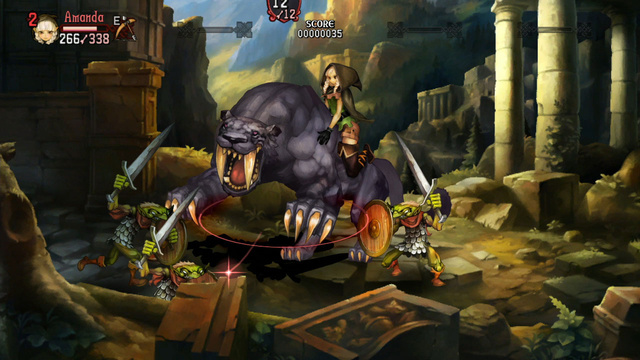
The inspiration taken from those older games is unmistakable — it’s almost distracting, really. From the moment I mounted my first attack panther, I was playing Golden Axe Evolution, a theoretical game that might have happened if the horrible Golden Axe: Beast Rider hadn’t.
Dragon’s Crown goes much deeper than the arcade battlers of yore. Each of the game’s nine main dungeons ends with the accumulation of experience points and the distribution of treasures, which for some annoying reason have to be identified before they can be used. Experience levels bring skill points, used to gain new powers and abilities in both general and class-specific categories. This allows players to craft specialised builds for each of the game’s six characters, tailoring them to their preferred play style.
There’s a level of depth to the game that’s, for the most part, purely optional. If a player wants to simply grab a Fighter — the game’s least nuanced character — and hack away, all they have to worry about keeping their equipment upgraded and repaired and picking up the odd pile of bones — the remains of dead adventurers strewn about dungeon floors, which can be resurrected to act as AI companions in single-player mode.
But single-player is not where the real joy of Dragon’s Crown lies. Once the initial set of dungeons is cleared (which took about seven hours, in my case), the game opens up online play, where friends can gather and strangers can be auto-matched into parties to take on the game’s advanced challenges.
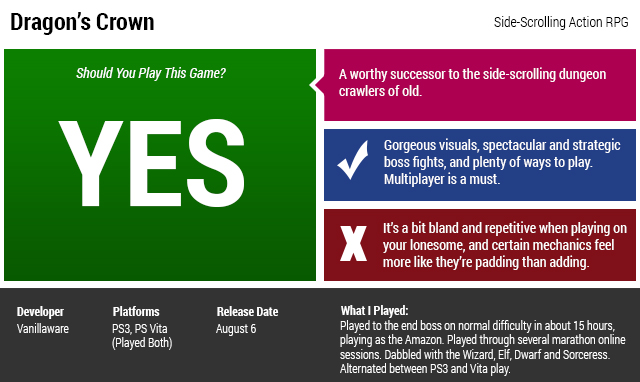
It’s in the midst of the fluid madness of multiplayer combat where Dragon’s Crown comes truly shines. Four heroes cooperating to take down a difficult boss, the more skilled carrying the less through to the very end. Four right analogue stick-controlled cursors on the screen, unlocking doors, activating runes or trying to poke at the portrait of an NPC during a dungeon cutscene. A single player with knowledge of the game’s spectacular boss fights somehow — without the benefit of voice chat — getting their compatriots to mass behind them as they pick up the shield to deflect the red dragon’s devastating fire breath.
It’s about four sets of hands greedily grabbing for ingredients during the between-dungeon cooking mini-game.
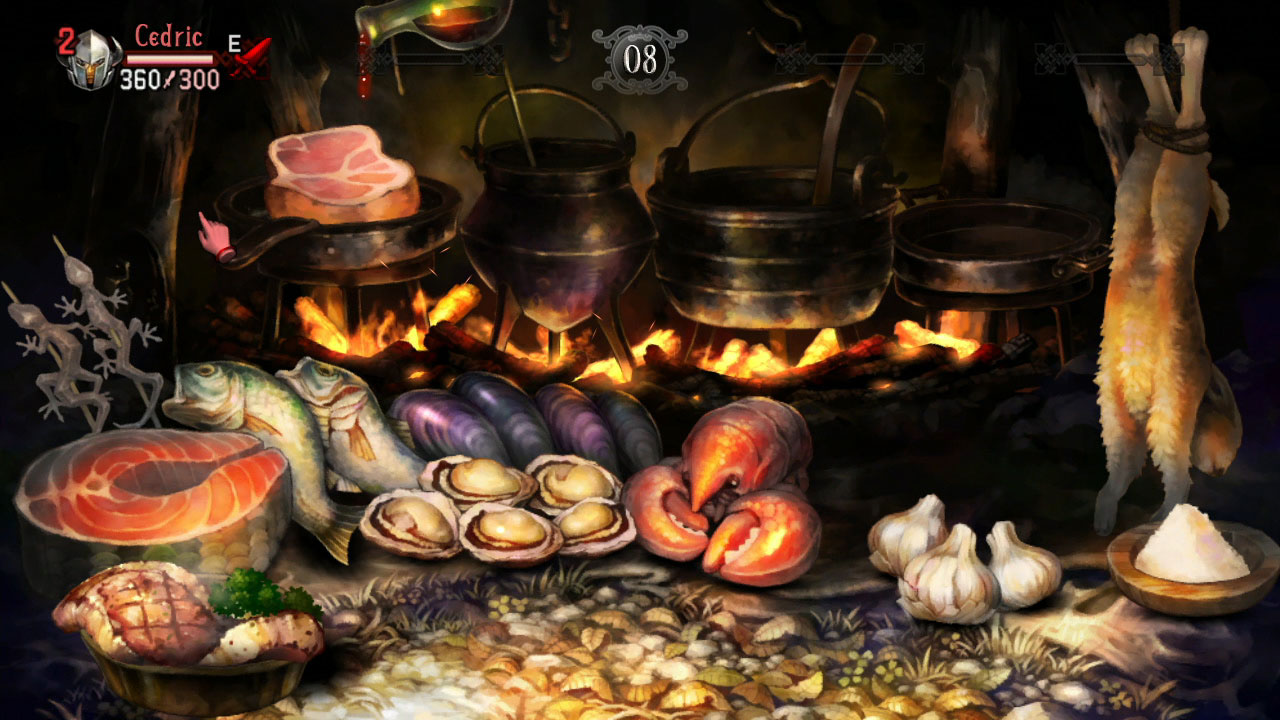
Honestly, before multiplayer opened up, I was getting bored with Dragon’s Crown. The scenery was pretty enough, but mashing on the square and circle buttons of my Dualshock as my borderline-moronic NPC allies flailed about was getting old. Now that I can play online — even taking into account that the second half of the game is the same nine dungeons enhanced with branching paths — I can easily see myself continuing past normal mode into what lies beyond, maybe even reaching the fabled level 99 cap with my Elf one far-off day.
I played Dragon’s Crown on both the PlayStation 3 and the PS Vita, thanks to the ability to upload and download save games to and from both systems. While the Vita suffers from noticeable slowdown during busy battles, the convenience of being able to advance my game no matter how long I was in the restroom is worth some stutter. If you’re serious about playing, getting both wouldn’t be a bad idea. It’s honestly the most action my Vita’s seen since Persona 4 Golden came out.
When I look at Dragon’s Crown now, I see a worthy successor to the games that first brought arcade action into the realm of role-playing. I see countless hours filled with chaotic dungeon-crawling, overcoming repetition through an endless parade of like-minded adventurers. I see a beautiful game that’s definitely worth exploring further. And yes, I see the exaggerated characters, but I don’t mind them so much. If you do, best move along.
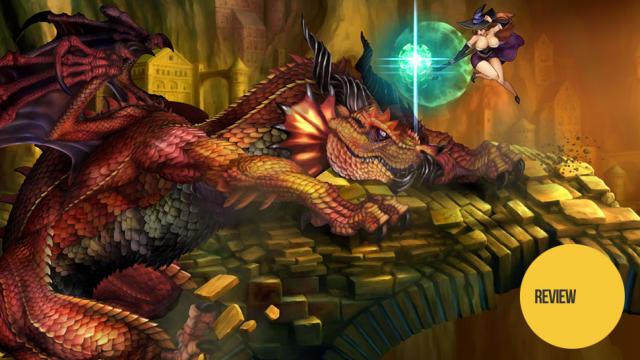
Comments
12 responses to “Dragon’s Crown: The Kotaku Review”
Awh still no Australian release date, I’d import if it wasn’t for PSN store restrictions which would stop me from buying DLC.
I’m not 100% certain, but I thought the restriction on DLC was that the Playstation Store will only show DLC for games released in the region you are in. So if you import a game that hasn’t been released locally, you won’t see any DLC for that game in the store. But if at a future time it gets a local release, the DLC will become available (doesn’t matter that your physical game is an import). Is this incorrect?
Correct, however this is easily circumnavigated by creating a profile for the region the game belongs to and downloading it from that store, the DLC will carry over to your local profile and work fine on the game.
While still possible on the VITA, the process is much more cumbersome, but is terribly simple on the PS3.
As they say in ancient Rome, “eat a dick, Schreier”.
I mean, I think it was ancient Rome.
So, who’s getting it? I would if I had any sort of Sony product from the last 7 years.
It totally has all of my want. But yeah, my house is a Nintendo house. I guess I could always just go and play the second half of Muramasa or something…
I was this close to getting the JP version that came out a few days ago. Then I saw English release date and said “I can wait until then”.
My copy from VGP shipped a day ago. So hype. Looking forward to playing on the train with Vita then swapping my save over to PS3 when I get home. Noice.
Does that mean you will be buying two copies of the game?
Yep 😉
Million dollar bills Y’all!!!
I must admit, I had never heard of this game until that recent Kotaku fiasco. So thank you Mr. No Laugh McKilljoy! You introduced me to a game thats right up my alley. Looks like a suped up version of the old D&D arcade game.
What are you? 14 years old?